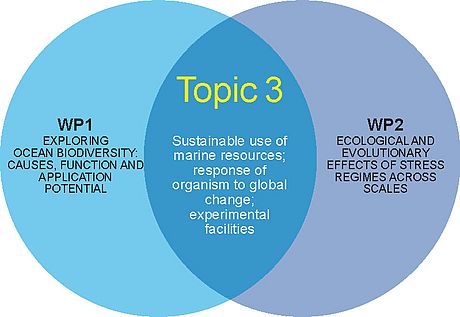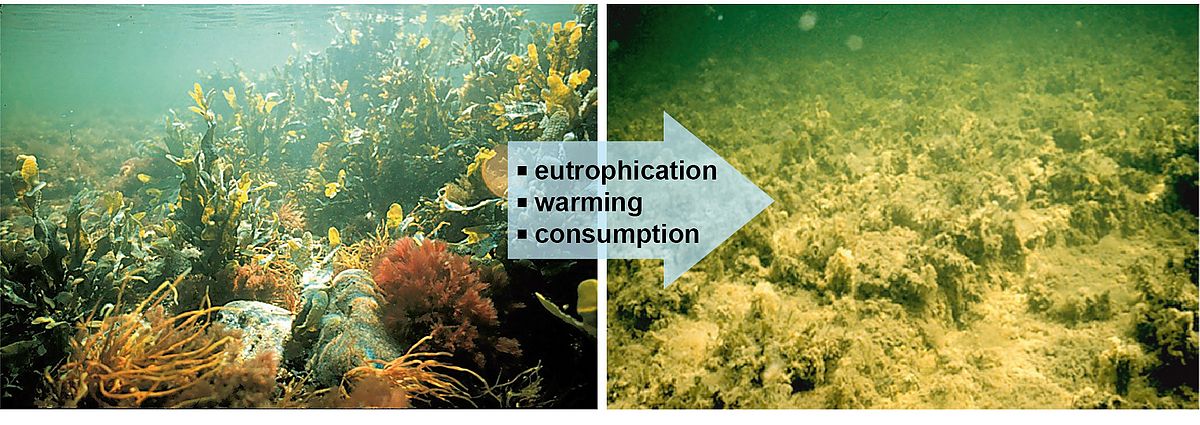Topic 3: Marine Biodiversity and Ecosystem Evolution
Topic speaker: Prof. Dr. Thorsten Reusch
(Deputy: Prof. Dr. Ulrich Sommer)
Mission:
The oceans’ biological diversity drives ecosystems and biogeochemical cycles. A deeper knowledge of existing diversity, associated processes and the reactions to environmental perturbations is needed to project future changes and to guide sustainable use of biological resources.
Challenges
Biological diversity in the world’s oceans is still poorly known, particularly in understudied areas such as tropical oceans and the deep sea. The ocean’s ecosystems are under multiple pressures, commonly subsumed under the heading “Global Change.” These include global (e.g. warming, ocean acidification, overfishing) and widespread regional (eutrophication, toxic pollution, invasive species, hypoxia) anthropogenic pressures which interact with natural pressures. At the same time, the human demand for biological marine resources is growing. Fish and other living resources are increasingly harvested from previously non-accessible marine environments, while the wide range of genes, molecular structures and substances in marine organisms are explored for medical and technical applications.
The various pressures on the ocean’s ecosystems do not act in isolation but may interact synergistically. Hence the combined effect of several factors cannot be predicted from studies addressing single factors, while effects on single species do not permit us to predict effects at the community level. Similarly, prediction of future ecosystem states is impossible without considering the evolutionary change of environmental tolerances and requirements of species. Thus, current efforts of marine global change research have to be up-scaled in time (in order to consider evolution) and with respect to the combinatorial action of many pressures.
Marine ecosystems provide many functions such as primary productivity, provisioning of three-dimensional physical structures such as leaf canopies or reefs, carbon fixation/sequestration and nutrient retention that depend on genetic, species and functional group diversity, which are also the basis for biogeochemical cycles [link to Topic 2]. Responses of ecosystem functions to pressures may be gradual and/or reversible or consist of regime shifts, which are difficult to reverse. This topic will view the oceans’ biological diversity from two sides – addressing the important role of such diversity for ecosystem functioning on the one hand and assessing the likely consequences of ongoing perturbations on diversity on the other. Overarching research themes are:
- Which mechanisms control marine biodiversity and community composition, and how will community composition and diversity be affected by ongoing global change in time and space?
- How do changes in marine biodiversity affect marine ecosystem functioning?
- How will physiological responses, evolutionary adaptation and compositional change interact with the overall ecosystem response to global change?
As a cross-cutting research theme, we assess the potential future use of living marine resources including genetic/genomic resources and natural substances that can be utilized for human application. How can we sustainably use marine resources by understanding the biology of the exploited species, in order to minimize effects on population sizes and biodiversity and the affected habitats?
Current Activities and Previous Work
Causal biodiversity research roots in theoretical ecology and was centred on the “competition – coexistence” issue, i.e. on the analysis of those factors which maintain biodiversity in spite of the natural tendency towards competitive exclusion. Experimental research used mainly microalgae as model organisms. Resource partitioning along gradients of resource ratios, spatial and temporal heterogeneity, disturbance of intermediate intensity and frequency, and consumption by higher trophic levels were identified as mechanisms countervailing competitive exclusion. The community-wide experiments within the DFG priority programme AQUASHIFT indicated a loss of plankton biodiversity with increasing climate warming. More recently, dispersal between local sub-communities within a regional metacommunity has been identified as a mechanism maintaining biodiversity, a research activity, which will be continued during the OCEANS programme period 2014-2018.
The role of species diversity for ecosystem functions was demonstrated in both benthic and pelagic experimental systems. Some examples are the importance of grazer diversity on benthic microalgae biomass and elemental composition. GEOMAR has also taken the lead in integrating the sub-species level of biodiversity into functional biodiversity research, for example the role of genotypic diversity in seagrass beds on resilience and productivity. Recent work focused on the importance of coccolithophore evolution and species diversity for the production and the formation of biogenic calcite in the context of ocean acidification.
GEOMAR's expedition based search for unknown biodiversity has concentrated on microbial biodiversity in hydrothermal vents, microbial biodiversity associated with symbiosis (e.g. bacteria-sponges, fungi-sponges) and to deep-sea and seamount cephalopods. In addition, GEOMAR hosts the headquarters of “fishbase” (www.fishbase.org), which is the world’s most complete database of a higher taxon. In addition, unique and large collections of several thousand marine bacteria and fungi are maintained at the Kiel Centre for Marine Natural Products (KiWiZ) and used to unravel their biotechnological potential for various applications (see 2.1.1 and 2.2.1). The high potential of microbes for the biosynthesis of biologically active compounds was demonstrated in representative groups revealing high numbers of bioactive substances that have a possible application potential.
Global change happens along several dimensions simultaneously, e.g. temperature, precipitation, cloudiness (irradiation) and storminess (mechanical stress, sedimentation), UV radiation, carbonate chemistry (ocean acidification), hypoxia and salinity. Thus, any impact caused by global change cannot be adequately addressed by studying single stressors or by using single species. Research during the past decade indicated that (i) stressors interact and their combined impact may be additive, synergistic or antagonistic, (ii) the sensitivity of a species depends on the genetic diversity of the population affected, while standing genetic variation may allow rapid local adaptation of populations, (iv) different ontogenetic stage(s) may differ in vulnerability, and (v) species may rapidly adapt to new stressor regimes. All of the above processes can alter the nature and sign of species interactions in complex ecosystems when one of several interacting species (e.g. consumers, competitors, or parasites) is more affected by global change than another.
During the past decade, GEOMAR’s research division „Marine Ecology,” had strong foci on the double role of diversity (as a cause for stability and a response to stress and disturbance), on the interaction between abiotic and biotic stress, on structuring effects of parasites, invasive species and chemical signals, and on the physiological mechanisms that govern important life cycle processes that are particularly vulnerable to global change.
Currently, we are in the process of creating realistic experimental settings for pelagic, open ocean organisms (i.e. fish larvae), and we strive to supplement single with multiple stressor studies and single species with multispecies assemblage experiments. To this end, scientists in Topic 3 are conducting experiments on many relevant scales, from microcosms to highly controlled mesocosms. Further integration considers different ontogenetic stages including early life stages of invertebrates, plants and fish. Disturbance and stress regimes now also encompass dynamic environmental regimes that consider enhanced variability. The devotion of our experimental studies to empirically testing key issues in theoretical ecology remain a distinctive feature of GEOMAR ecology and distinguish it from other marine institutes within the Helmholtz, Leibniz and Max-Planck Societies. Another important new approach is the use of state-of-the art transcriptomic and genomic techniques to study the rapid evolvability of local populations as a function of their adaptive genetic diversity. Adapted phenotypes will be studied using biochemical, molecular genetic, cell biological and physiological techniques in order to understand mechanisms of adaptation.
Objectives
The overall goal of this programme topic is to expose populations and communities of variable composition and (genetic, taxonomic and/or functional) diversity to predicted multi-factorial change and to assess their response regarding performance, re-structuring and functional changes. One focus will be the sensitivity of populations at range margins and in extreme habitats. Experiments will be run at different spatial and temporal scales and levels of complexity: from individuals to clonal cultures to microcosm communities artificially assembled from culture and natural communities in indoor and field mesocosms. The variables measured are genetic changes within populations (i.e. microevolution), community compositional changes and variables of ecosystem functioning such as nutrient retention and primary productivity. Experimental research will be supplemented by the analysis of long-term field data and field studies along environmental gradients in order to validate results from smaller strictly experimental set-ups. Key structural species (e.g. macrophytes, mussel beds, corals) will require special attention, because they are the foundation of entire communities. Embedded into an ecosystem approach, the population biology of exploitable stocks of marine living resources and strategies for their sustainable use will be studied. The adaptive diversity of species and populations will be characterized and quantified using modern cell biological, physiological and genomic tools, with the mid-term goal to find correlates of adaptive potential directly encoded in the genes of marine organisms. Marine substances and genetic genomic resources will be discovered, isolated and tested with state-of-the-art genomic and meta-genomic analytical tools.
To achieve the described goals, the topic is organized into two mutually interdependent work packages. While WP1 sees biodiversity rather as a driver of ecosystem processes, WP2 explores how diversity is impaired by the multitude of stressors acting upon contemporary populations, communities and ecosystems. Embedded into both work packages are questions of sustainable resource use. In WP1, the application potential of microbial diversity will be addressed, while WP2 explicitly includes the responses of harvestable resources by multiple stressors.
Work Package 1 (Exploring Ocean Biodiversity: causes, function and application potential) has a triple goal in exploring hitherto unknown marine biodiversity, including genes /substances with application potential, understanding the cause of biodiversity change, and predicting the risks for ecosystem functioning resulting from biodiversity loss.
Work Package 2 (Ecological and evolutionary effects of stress regimes across scales) will study biological effects of global change interacting with regional pressures. To this end, approaches will be scaled up temporally, spatially and methodologically. Experimental studies from the species to the community level will be integrated with the assessment of the mechanistic basis of interactions among stressors and the modulation of biotic interactions, including different ontogenetic phases and an evolutionary ecology approach.




